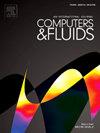A Python-based flow solver for numerical simulations using an immersed boundary method on single GPUs
IF 2.5
3区 工程技术
Q3 COMPUTER SCIENCE, INTERDISCIPLINARY APPLICATIONS
引用次数: 0
Abstract
We present an efficient implementation for the simulation of three-dimensional, incompressible flow around moving bodies with complex geometries on single GPUs, based on Nvidia CUDA through Numba and Python. The flow is solved in this framework through an implementation of the Immersed Boundary Method tailored for the GPU, where different GPU grid architectures are exploited to optimize the overall performance. By targeting a single-GPU, we eliminate the need for both intra- and inter-node communication, which can potentially introduce overheads. With this approach, all simulation data remains in the GPU’s global memory at all times. We provide details about the numerical methodology, the implementation of the algorithm in the GPU and the memory management, critical in single-GPU implementations. Additionally, we verify the results comparing with our analogous CPU-based parallel solver and assess satisfactorily the efficiency of the code in terms of the relative computing time of the different operations and the scaling of the CPU code compared to a single GPU case. Overall, our tests show that the single-GPU code is between 34 to 54 times faster than the CPU solver in peak performance (96–128 CPU cores). This speedup mainly comes from the change in the method of solution of the linear systems of equations, while the speedup in sections of the algorithm that are equivalent in the CPU and GPU implementations is more modest (i.e., speedup in the computation of the non-linear terms). Finally, we showcase the performance of this new GPU implementation in two applications of interest, one for external flows (i.e., bioinspired aerodynamics) and one for internal flows (i.e., cardiovascular flows), demonstrating the strong scaling of the code in two different GPU cards (hardware).
基于python的单gpu浸入边界法数值模拟流动求解器
我们通过Numba和Python,基于Nvidia CUDA,在单个gpu上提供了一个有效的实现,用于模拟具有复杂几何形状的运动物体周围的三维不可压缩流。该流程通过为GPU量身定制的浸入边界方法的实现在该框架中解决,其中利用不同的GPU网格架构来优化整体性能。通过针对单个gpu,我们消除了对节点内和节点间通信的需求,这可能会带来开销。通过这种方法,所有模拟数据始终保留在GPU的全局内存中。我们提供了关于数值方法的详细信息,算法在GPU中的实现和内存管理,这在单GPU实现中至关重要。此外,我们将结果与类似的基于CPU的并行求解器进行比较,并根据不同操作的相对计算时间和CPU代码与单个GPU情况相比的缩放来满意地评估代码的效率。总的来说,我们的测试表明,在峰值性能(96-128个CPU核)下,单gpu代码比CPU求解器快34到54倍。这种加速主要来自线性方程组解方法的改变,而在CPU和GPU实现中等价的算法部分的加速则更为适度(即,非线性项的计算加速×1.6−3)。最后,我们在两个感兴趣的应用程序中展示了这种新GPU实现的性能,一个用于外部流(即,生物启发空气动力学),一个用于内部流(即,心血管流),展示了两种不同GPU卡(硬件)中代码的强大缩放。
本文章由计算机程序翻译,如有差异,请以英文原文为准。
求助全文
约1分钟内获得全文
求助全文
来源期刊

Computers & Fluids
物理-计算机:跨学科应用
CiteScore
5.30
自引率
7.10%
发文量
242
审稿时长
10.8 months
期刊介绍:
Computers & Fluids is multidisciplinary. The term ''fluid'' is interpreted in the broadest sense. Hydro- and aerodynamics, high-speed and physical gas dynamics, turbulence and flow stability, multiphase flow, rheology, tribology and fluid-structure interaction are all of interest, provided that computer technique plays a significant role in the associated studies or design methodology.
 求助内容:
求助内容: 应助结果提醒方式:
应助结果提醒方式:


